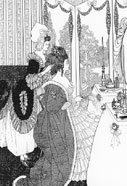 |
 |
Alliteration and Assonance Revisited
Task A - Is all sound repetition alliteration or assonance?
Below are some lines from a famous poem by the C18 poet, Alexander Pope.
It is written in rhyming couplets and he called it 'an heroi-comical poem'.
He wrote it in response to hearing about a high-society quarrel between
two noble families over the fact that Lord Petre had forcibly cut off
a lock of Miss Arabella Fermor's hair. Pope's poem makes fun of this incident.
Here, his 'heroine' the Lady Belinda, is seated at her dressing table,
putting her make-up on.
 |
Here piles of pins extend their shining rows,
Puffs, Powders, Patches, Bibles, Billets-doux.
Now awful Beauty puts on all its Arms;
The Fair each moment rises in her Charms, . . .
|
|
(Alexander Pope  ,
'The Rape of the Lock', Canto I, 137-40) ,
'The Rape of the Lock', Canto I, 137-40)
|
The satire is obvious enough in the third line of the quotation,
in the phrase 'awful Beauty' and the ludicrous implicit comparison between
putting on make-up and preparing for battle. But we are going to concentrate
on alliteration and associated effects.
What patterns of /p/ alliteration can you see in
lines 1 and 2. Are they all equally strong? What effects do you think
are associated with them? Discuss your ideas with a partner, making notes
as you do so, compare your findings with ours.
Our findings for task A
|
Here piles of pins extend their shining rows,
|
/hɪəpaɪlzəvpɪnzekstendðɛəʃaɪniŋrəʊz |
|
Puffs, Powders, Patches, Bibles, Billets-doux.
|
pʌfspɑʊdəzpæʧɪzbaɪblzbɪlɪdəʊz |
|
Now awful Beauty puts on all its Arms;
|
nɑʊɔ:flbju:tɪpʊtsɒnɔ:lɪtsɑ:mz |
|
The Fair each moment rises in her Charms, . . .
|
ðəfɛəi:ʧməʊməntraɪzɪzɪnhɜ:ʧɑ:mz/ |
(Alexander Pope, 'The Rape of the Lock', Canto I, 137-40)
The most obvious example of /p/ alliteration
is that between 'Puffs' /pʌfs/,
'Powders' /pɑʊdəz/ and 'Patches'
/pæʧɪz/. These are marked graphologically
by the initial capitalisation as well as the repetition of the /p/ phoneme. The alliteration also ties together a string of nouns which
go together semantically: they are all cosmetic items (powders and puffs
are obvious enough; patches are C18 beauty spots).
But does the alliterative pattern include 'piles' /paɪlz/ and 'pins' /pɪnz/ in the previous line?
The words involved are not capitalised and are a bit further away (but
not much), so the effect is probably not felt as strongly as that between
''Puffs', 'Powders' and 'Patches'. But although the pins (presumably
hair pins) are not examples of make-up, they are part of the armoury
for making someone beautiful. So there is a good interpretative reason
for wanting to include them in the same alliterative pattern.
The next really obvious one is the /b/ alliteration between 'Bibles' /baɪblz/ and 'Billets-doux' /bɪlɪdəʊz/ (the French term for love letters, here with the Anglicised pronunciation to make the rhyme). This alliteration
clearly brings with it an ironic contrast. Although the parallel alliteration
and the orthography suggest that we are to see these items as equivalent,
they are of very different status. At the time a Bible was a very serious
thing to read (and indeed still is today, even if you happen not to
be religious). But the love letters of high society ladies were much
more trivial. Here, then, we can see the working at the phonetic level (alliteration) to bring out an
ironic contrast. Although Bibles and love-letters are very different
in status, the Lady Belinda appears to treat them as equivalent (they
are both on her dressing table), helping us to smile at her.
But does the alliteration go across the whole line? Do the /p/ and /b/ words alliterate? What do you
think?
We would argue that it does. First of all, the /p/ and /b/ items in the second line of the
quotation are also parallel grammatically - they are all nouns in a
list construction which suggests they are to be seen as equivalent.
Moreover, although /p/ and /b/ are different phonemes, they are very similar to one another in articulatory
terms. They are both stops which are bilabial (stopped by putting the
two lips together). And although the /p/ alliterating items are all to do with cosmetics and the /b/ items are examples of reading matter, they are all items strewn across
the Lady Belinda's dressing table. If you see the ironic contrast in
the line being between 'Bibles' and ALL the other items we have mentioned,
then you are probably perceiving the /p/ alliteration pattern and the /b/ alliteration
pattern as also being linked together in a looser /p/b/ alliterative pattern.
Incidentally, as the couplet rhyme scheme forces us to
produce an overtly Anglicised pronunciation for the love letters: (/bɪlɪdəʊz/),
this joke pronunciation helps to lower the status of the love letters.
|

